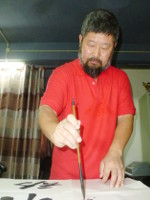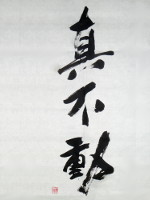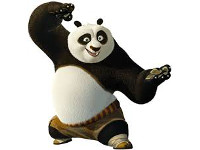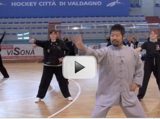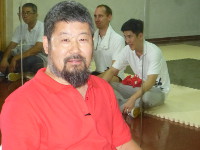 Another year, another step up to see the grand vista of Tai chi. I was able to once again participate in Master Joseph Chen Zhonghua workshop organized by Nicholas Feng, K.T. Lin, Hong Kong Chen Style Taiji Practical Method (香港陳式太極實用拳法).
Another year, another step up to see the grand vista of Tai chi. I was able to once again participate in Master Joseph Chen Zhonghua workshop organized by Nicholas Feng, K.T. Lin, Hong Kong Chen Style Taiji Practical Method (香港陳式太極實用拳法).
On a mild holiday weekend, more than thirty participants from Hong Kong, the Mainland, Canada and India gathered to train with Master Chen. A special thanks to Ling Zili who came from Daqinshan to help with the workshop. For two days, Master Chen started with the foundations, then continued with moving, the first thirteen moves of Yilu and occasional bouts of applications training. Master Chen clearly explain how each type of training is directly related to theory of Chen Taijiquan.
Mahler’s Mighty Third (馬勒第三交響曲 )
In my short visit to Hong Kong, I attended a concert of Mahler’s Mighty Third (馬勒第三交響曲 ) performed by Hong Kong Philharmonic (香港管弦樂團由). This symphony provided a great frame work to discuss my experience with the Hong Kong workshop.In the symphony, Mahler capture his vision of the the cycle of nature. Master Chen’s workshop captures the cycle of a student’s martial arts experience. For Mahler, the symphony was inspired by the words of Nietzsche. In the workshop, the spirit of the teachings of Master Hong and Master Chen captures the essence of the ancient art of Taijiquan.
“Pan Awakens. The triumphal entry of summer”
「牧神甦醒,夏季昂首闊步地邁進」
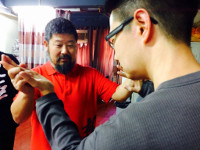 As I travel the world, reading and discussing the stories of those that participated in the workshop of Master Chen, a common question for each participant concerns their reasons for attending a workshop. In general, they came either through a friend’s recommendation or through their own research on the Internet. Attendees came from a variety of background, age group and physical abilities. Many have years of experience with various forms of martial arts. Some people are young but many are older. Some people leads an active life but there were others that are more sedentary in nature. Each participant brings with them their own ideas relating to health, martial arts and Taiji.
As I travel the world, reading and discussing the stories of those that participated in the workshop of Master Chen, a common question for each participant concerns their reasons for attending a workshop. In general, they came either through a friend’s recommendation or through their own research on the Internet. Attendees came from a variety of background, age group and physical abilities. Many have years of experience with various forms of martial arts. Some people are young but many are older. Some people leads an active life but there were others that are more sedentary in nature. Each participant brings with them their own ideas relating to health, martial arts and Taiji.
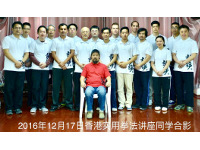 Over the course of a workshop, Master Chen and his students patiently introduce the concept of the Practical Method to those new participants. In most cases, this first introduction challenges their understanding of Taiji both on a philosophical and a physical level. The commonly held belief of using “qi” (Chi or “”) as the bases of Taiji training is one of the first concept that is abandoned. Since such concept is not well understood in Chinese history let alone translated correctly for the Western audience. In its place, the use of physical concepts such as energy and power are used. Another difficulty for beginners is the physical requirements of the Practical Method. The training requires exactness and accuracy that are different from other forms of training. This type of training confronts the practitioner regardless the level of physical fitness. Beginners struggles with the coordination of various body parts and finding out their own physical and mental limitations. In the compress time frame of a workshop, the mental and physical toil provokes the following types of reactions to the first time participants.
Over the course of a workshop, Master Chen and his students patiently introduce the concept of the Practical Method to those new participants. In most cases, this first introduction challenges their understanding of Taiji both on a philosophical and a physical level. The commonly held belief of using “qi” (Chi or “”) as the bases of Taiji training is one of the first concept that is abandoned. Since such concept is not well understood in Chinese history let alone translated correctly for the Western audience. In its place, the use of physical concepts such as energy and power are used. Another difficulty for beginners is the physical requirements of the Practical Method. The training requires exactness and accuracy that are different from other forms of training. This type of training confronts the practitioner regardless the level of physical fitness. Beginners struggles with the coordination of various body parts and finding out their own physical and mental limitations. In the compress time frame of a workshop, the mental and physical toil provokes the following types of reactions to the first time participants.
For many, they retreat back to their safety and comfort of the familiar and does not pursuit any further training. For some, they recognize some difference in the training approach and will seek further instructions. However, because they have yet abandon their preconceived notions, their progress will be slow. For the rare few, who saw the uniqueness of the training. They will invest their time and energy to really understand the art. They are the ones that really benefited from the workshop.
“What the Flowers in the Meadow Tell Me”
「草地上花兒跟我說」
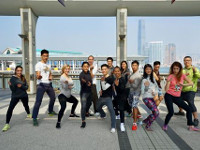 After you attend more than one workshops, are active on the Practical Method website or participate through various social media outlets, you will discover many familiar names. They have persisted in their Practical Method’s training and they form a community that helps each other to improve their understanding of Taiji. Like many things in life, learning requires active participation in-order to achieve progress.
After you attend more than one workshops, are active on the Practical Method website or participate through various social media outlets, you will discover many familiar names. They have persisted in their Practical Method’s training and they form a community that helps each other to improve their understanding of Taiji. Like many things in life, learning requires active participation in-order to achieve progress.
“What the Animals in the Forest Tell Me”
「林中鳥獸跟我說」
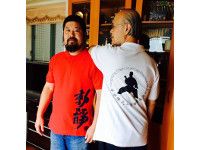 For the the dedicate few, who really enjoy and recognize the benefits of training in the Practical Method, they become instructors and disciples of Master Chen. They realize that the best way to learn is to try to explain the subject to another person. Learning through demonstration is according to the basic principles of the Practical Method. As Master Hong said, both “Honesty” (感情真) and “Detailed Demonstration” (細示範) are the requirements for a teacher.
For the the dedicate few, who really enjoy and recognize the benefits of training in the Practical Method, they become instructors and disciples of Master Chen. They realize that the best way to learn is to try to explain the subject to another person. Learning through demonstration is according to the basic principles of the Practical Method. As Master Hong said, both “Honesty” (感情真) and “Detailed Demonstration” (細示範) are the requirements for a teacher.
Sponsor and organizers of the workshop are the dedicated few that are working hard to promote the teachings of the Practical Method. They provide everyone with the opportunity to receive a direct transmission of Taijiquan from Master Chen. The workshops or a trip to Daqinshan are the only means of maintaining the traditional art of Taijiquan. To paraphrase an old adage “If you cannot go to the mountain, it is fortunate that the mountain can come to you.”
“What Man Tells Me”
「人跟我說」
Mahler’s inspiration was embedded in the symphony through the following song:
| “Zarathustras Mitternachtslied” (aus Also sprach Zarathustra von Nietzsche) |
「查拉圖斯特拉午夜之歌」 (取材自尼采著作「查拉圖斯特拉如是說」 |
| O Man! Take heed! | 人哪,聽著! |
| What says the deep midnight? | 深沉的午夜在說甚麼? |
| “I slept, I slept—, | 我睡了,我睡了— |
| from a deep dream have I awoken: | 我從深沉的夢裡醒來; |
| the world is deep, | 世界是深沉的, |
| and deeper than the day has thought. | 比白晝所想的還要深沉。 |
| Deep is its pain—, | 深沉是世界的痛苦; |
| joy—deeper still than heartache. | 快樂比起悲痛更深更沉; |
| Pain says: Pass away! | 痛苦在說:「走吧!」 |
| But all joy seeks eternity, | 可惜快樂渴望永恆— |
| seeks deep, deep eternity!” | 深沉,深沉的永恆。 |
Nietzsche tries to convey the feeling of epiphany in words. Mahler tries to represents this same moment in music. There is the same exquisite feeling when I get caught by a perfect taiji technique or I understood a new concept in Taiji theory.
“What the Angels Tell Me”
「天使跟我說」
Just like Master Hong, Master Chen said he is only teaching what his teachers taught him. Even in Master Chen’s calligraphy, Master Chen is only copying the words that Hong used in his book.
One of the hardest things to get used to in learning Taijiquan is the difference in philosophical viewpoints. Part of this difference can be attributed to culture but on a more fundamental level, the system is completely different and should not understood by mapping your own particular bias to this new approach. So the question remains, how do you know that you are traveling on the correct path. Luckily, we have Master Chen to act as a guide. He can navigate the Chinese cultural nuances as well as providing well known physical landmarks to guide our exploration. Here is an example during the Hong Kong Workshop.
We started with some partner drills and push hands exercises. A question comes up about a particular movement and its use. The group had difficulty replicating the effects of this technique. Master Chen then said. “(In a Taiji technique), what you see visually is not what you do physically. In nature, you can see intent before the action. Taiji training, you cannot see the intent, you only have the result of the action.”
This short idea made me remember the first time I asked Master Chen for a correction on a technique. I asked, what does the technique feel like? What is the feedback? Master Chen reply “Just do the technique. There is no feedback.” I argued back, so how will I know if the technique is correct? Master Chen replied “It is correct if you obeyed the principles.” At that time, I thought he was kidding but now this idea makes more sense.
The interplay of application and theory is an important aspect of a workshop. The essences of the Practical Method is that theory is always tested by a physical result. Theory, however, can be expressed in different ways but the result is the same. During the workshop, Master Chen discussed the idea of Five Have and Five Have-Nots (五有五無), The Five Haves are: two feet, two hands and the head. They must not move. The five Have-nots are: the two shoulder, the two kua, and the Dantian. They must dissolved. The Five Have and Five Have-nots can be related to concept of the Three Rings of Taiji as well as the idea of “cutting off the shoulder”. Each of those theoretical concepts have the practitioner achieve the proper action based on Taiji principles. This action creates an unexpected reaction on another person.In the short time frame of a workshop, it is hard to see the path but
Master Hong reminds us, In “The Taijiquan Treatise” (太极拳论), this idea [of many different expressions] is expressed as “Although there are myriad variations, there is only one underlying principles.” (“虽变化万端, 而理为一贯”). Master Chen provides many different landmarks but in the end all Practical Methods practitioners are traveling on the same path.
“What Love Tells Me”
「愛跟我說」
Practical Method training has changed my perspective and understanding of the world. Often, I can see the lessons taught by Master Chen being applied in the real world not just in terms of the martial arts but in general. I was watching Kung Fu Panda (功夫熊猫)one day and noticed thatOogway (龜大仙) said “Yesterday is history, tomorrow is a mystery, but today is a gift. That is why it is called the present.” I recalled Master Chen commenting along the same lines. Coincidentally, Master Chen told me about his trip to Australia. In a meeting with some Australian kids, they asked him whether Panda is a martial artist. Master Chen replied, “No, Panda are cowboys”. The kids were puzzled and Master Chen replied “Because they eat shoots leaves.” Training the ancient art of Taijiquan in modern times is like this, “You need to train seriously but sometimes you don’t have to be too serious to train.”
Looking forward to more Workshops in the Year of the Rooster!
 |
| Happiness in the year of the Rooster, all the best |
| 鸡年大吉, 万事如意 |


